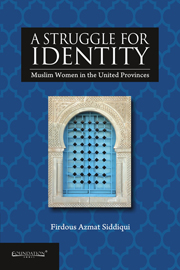Book contents
- Frontmatter
- Contents
- Acknowledgements
- Introduction
- 1 Social Stratification of Muslim Women in the United Provinces
- 2 Socio-religious Movement and the Muslim Women's Issue
- 3 British Perception of Muslim Women: Questions of Fecundity and Health
- 4 Crises in the Social and Economic Identity of Muslim Women: The Great Uprising of 1857
- 5 Changing Profile of Muslim Women through Education
- 6 Patriarchy and Social Obligation of Indian Muslim Women
- 7 Cultural Clash: From Tawaif to Kasbi
- 8 Law, Land and Muslim Women: The Economic Situation
- 9 Muslim Women's Response to the New Judicial System
- Conclusion
- Glossary
- Bibliography
- Index
5 - Changing Profile of Muslim Women through Education
Published online by Cambridge University Press: 05 October 2014
- Frontmatter
- Contents
- Acknowledgements
- Introduction
- 1 Social Stratification of Muslim Women in the United Provinces
- 2 Socio-religious Movement and the Muslim Women's Issue
- 3 British Perception of Muslim Women: Questions of Fecundity and Health
- 4 Crises in the Social and Economic Identity of Muslim Women: The Great Uprising of 1857
- 5 Changing Profile of Muslim Women through Education
- 6 Patriarchy and Social Obligation of Indian Muslim Women
- 7 Cultural Clash: From Tawaif to Kasbi
- 8 Law, Land and Muslim Women: The Economic Situation
- 9 Muslim Women's Response to the New Judicial System
- Conclusion
- Glossary
- Bibliography
- Index
Summary
Likh kar hamara nam zameen par mita Dia
Lo aaj hamne uska bhi jhagra mita Dia
Taqseer yar ki na qasoor-e ard hai kuch
Akhtar hamare dil hi ne hamko jala dia
Nawab Akhtar Mahal, AkhtarIn the field of social sciences, the second half of the nineteenth century in India is generally considered a period of transition, both socially and economically. The revolt of 1857 led to significant changes, not only in British administrative policies but also in the attitudes of the subjects of the British Empire in India. The second half of the nineteenth century, according to Natrajan, was a period of social reform. However, the general belief of Muslim scholars is that there was a growing consciousness among Hindus to bring about social change, while the Indian Muslims chose to remain in a backward state. In the second half of the nineteenth century, social awareness for reform was generally gauged by the growing literacy rate amongst Hindu women, and it was assumed that educationally, Indian Muslim women lagged behind considerably.
This chapter reviews the state of education among women, particularly Indian Muslim women, in the United Provinces. This chapter states that like their Hindu counterparts, Indian Muslim women, too, were educated. Again, like Hindu women, education among Indian Muslim women was determined by class demarcations in social and economic terms.
- Type
- Chapter
- Information
- A Struggle for IdentityMuslim Women in United Provinces, pp. 76 - 108Publisher: Foundation BooksPrint publication year: 2014

